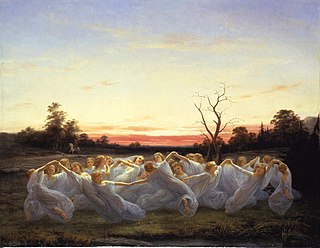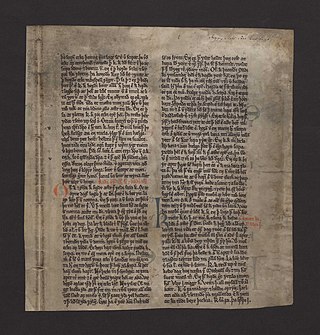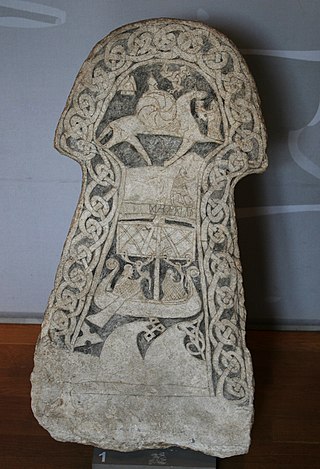
An elf is a type of humanoid supernatural being in Germanic folklore. Elves appear especially in North Germanic mythology, being mentioned in the Icelandic Poetic Edda and Snorri Sturluson's Prose Edda.
"Edda" is an Old Norse term that has been applied by modern scholars to the collective of two Medieval Icelandic literary works: what is now known as the Prose Edda and an older collection of poems now known as the Poetic Edda. The term historically referred only to the Prose Edda, but this usage has fallen out of favour because of confusion with the other work. Both works were recorded in Iceland during the 13th century in Icelandic, although they contain material from earlier traditional sources, reaching back into the Viking Age. The books provide the main sources for medieval skaldic tradition in Iceland and for Norse mythology.

Heimskringla is the best known of the Old Norse kings' sagas. It was written in Old Norse in Iceland by the poet and historian Snorri Sturluson (1178/79–1241) c. 1230. The title Heimskringla was first used in the 17th century, derived from the first two words of one of the manuscripts.

The sagas of Icelanders, also known as family sagas are a subgenre, or text groups of Icelandic sagas. They are prose narratives mostly based on historical events that mostly took place in Iceland in the ninth, tenth, and early eleventh centuries, during the so-called Saga Age. They were written in Old Icelandic, a western dialect of Old Norse. They are the best-known specimens of Icelandic literature.

In Norse mythology Valhalla is the anglicised name for Old Norse: Valhǫll. It is described as a majestic hall located in Asgard and presided over by the god Odin. Half of those who die in combat enter Valhalla, while the other half are chosen by the goddess Freyja to reside in Fólkvangr. The masses of those killed in combat along with various legendary Germanic heroes and kings, live in Valhalla until Ragnarök when they will march out of its many doors to fight in aid of Odin against the jötnar.

Yule is a winter festival historically observed by the Germanic peoples that was incorporated into Christmas during the Christianisation of the Germanic peoples. In present times adherents of some new religious movements celebrate Yule independently of the Christian festival. Scholars have connected the original celebrations of Yule to the Wild Hunt, the god Odin, and the heathen Anglo-Saxon Mōdraniht. The term Yule and cognates are still used in English and the Scandinavian languages as well as in Finnish and Estonian to describe Christmas and other festivals occurring during the winter holiday season. Furthermore, some present-day Christmas customs and traditions such as the Yule log, Yule goat, Yule boar, Yule singing, and others may have connections to older pagan Yule traditions.

A dwarf is a type of supernatural being in Germanic folklore. Accounts of dwarfs vary significantly throughout history; however, they are commonly, but not exclusively, presented as living in mountains or stones and being skilled craftspeople. In early literary sources, only males are explicitly referred to as dwarfs. However, they are described as having sisters and daughters, while male and female dwarfs feature in later saga literature and folklore. Dwarfs are sometimes described as short; however, scholars have noted that this is neither explicit nor relevant to their roles in the earliest sources.
The Forsyte Saga, first published under that title in 1922, is a series of three novels and two interludes published between 1906 and 1921 by the English author John Galsworthy, who won the 1932 Nobel Prize in Literature. They chronicle the vicissitudes of the leading members of a large upper-middle-class English family that is similar to Galsworthy's. Only a few generations removed from their farmer ancestors, its members are keenly aware of their status as "new money". The main character, the solicitor and connoisseur Soames Forsyte, sees himself as a "man of property" by virtue of his ability to accumulate material possessions, but that does not succeed in bringing him pleasure.

The Poetic Edda is the modern name for an untitled collection of Old Norse anonymous narrative poems in alliterative verse. It is distinct from the closely related Prose Edda, although both works are seminal to the study of Old Norse poetry. Several versions of the Poetic Edda exist: especially notable is the medieval Icelandic manuscript Codex Regius, which contains 31 poems.

In Norse mythology, a valkyrie is one of a host of female figures who guide souls of the dead to the god Odin's hall Valhalla. There, the deceased warriors become einherjar. When the einherjar are not preparing for the cataclysmic events of Ragnarök, the valkyries bear them mead. Valkyries also appear as lovers of heroes and other mortals, where they are sometimes described as the daughters of royalty, sometimes accompanied by ravens and sometimes connected to swans or horses.

The Norsemen were a North Germanic linguistic group of the Early Middle Ages, during which they spoke the Old Norse language. The language belongs to the North Germanic branch of the Indo-European languages and is the predecessor of the modern Germanic languages of Scandinavia. During the late eighth century, Scandinavians embarked on a large-scale expansion in all directions, giving rise to the Viking Age. In English-language scholarship since the 19th century, Norse seafaring traders, settlers and warriors have commonly been referred to as Vikings. Historians of Anglo-Saxon England distinguish between Norse Vikings (Norsemen) from Norway, who mainly invaded and occupied the islands north and north-west of Britain, as well as Ireland and western Britain, and Danish Vikings, who principally invaded and occupied eastern Britain.
Sagas are prose stories and histories, composed in Iceland and to a lesser extent elsewhere in Scandinavia.
Ivar the Boneless, also known as Ivar Ragnarsson, was a Viking leader who invaded England and Ireland. According to the Tale of Ragnar Lodbrok, he was the son of Aslaug and her husband Ragnar Loðbrok, and was the brother of Björn Ironside, Halvdan Hvitserk, Sigurd Snake-in-the-Eye and Ragnvald. However, this is not sure to be historically accurate. Ivar is probably the same person as Ímar, a Viking king of Dublin between 870 and 873. He might have been born in Uppsala, Sweden in about 787.
Old Norse literature refers to the vernacular literature of the Scandinavian peoples up to c. 1350. It chiefly consists of Icelandic writings.
Icelandic literature refers to literature written in Iceland or by Icelandic people. It is best known for the sagas written in medieval times, starting in the 13th century. As Icelandic and Old Norse are almost the same, and because Icelandic works constitute most of Old Norse literature, Old Norse literature is often wrongly considered a subset of Icelandic literature. However, works by Norwegians are present in the standard reader Sýnisbók íslenzkra bókmennta til miðrar átjándu aldar, compiled by Sigurður Nordal on the grounds that the language was the same.
A prosimetrum is a poetic composition which exploits a combination of prose (prosa) and verse (metrum); in particular, it is a text composed in alternating segments of prose and verse. It is widely found in Western and Eastern literature. While narrative prosimetrum may encompass at one extreme a prose story with occasional verse interspersed, and at the other, verse with occasional prose explanations, in true prosimetrum the two forms are represented in more equal measure. A distinction is sometimes drawn between texts in which verse is the dominant form and those in which prose dominates; there the terms prosimetrum and versiprose are applied respectively.

The Broken Sword is a fantasy novel by American writer Poul Anderson, originally published on 5 November 1954. It was issued in a revised edition by Ballantine Books as the twenty-fourth volume of their Ballantine Adult Fantasy series in January 1971. The original text was returned to print by Gollancz in 2002. The novel is set during the Viking Age and the story contains many references to the Norse mythology.

Odin is a widely revered god in Germanic paganism. Norse mythology, the source of most surviving information about him, associates him with wisdom, healing, death, royalty, the gallows, knowledge, war, battle, victory, sorcery, poetry, frenzy, and the runic alphabet, and depicts him as the husband of the goddess Frigg. In wider Germanic mythology and paganism, the god was also known in Old English as Wōden, in Old Saxon as Uuôden, in Old Dutch as Wuodan, in Old Frisian as Wêda, and in Old High German as Wuotan, all ultimately stemming from the Proto-Germanic theonym *Wōðanaz, meaning 'lord of frenzy', or 'leader of the possessed'.
Ursula Miriam Dronke was an English medievalist and former Vigfússon Reader in Old Norse at the University of Oxford and an Emeritus Fellow of Linacre College. She also taught at the University of Munich and in the Faculty of Modern and Medieval Languages at Cambridge University.
Heather O'Donoghue is a British academic. She is Professor of Old Norse and Vigfusson Rausing Reader in Ancient Icelandic Literature and Antiquities at the University of Oxford. She is a Fellow of Linacre College, Oxford.










